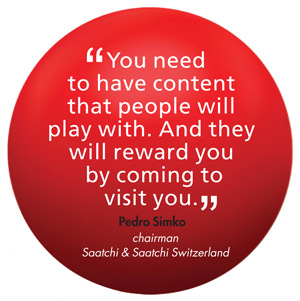|
In-Depth
Customer Acquisition
Marketing has changed from telling customers about your product to interacting with customers about your product.
By Lara Ewen

The visionary management expert Peter Drucker “used to say that everything in a company is marketing and innovation. Everything else is just overhead,” according to Mark Schaefer, executive director of Knoxville, Tennessee–based consulting firm Schaefer Marketing Solutions. Schaefer, who studied under Drucker at his School of Management in California, is currently a professor of marketing at Rutgers University, as well as the author of three best-selling marketing books. Agreeing with Drucker’s assessment, he adds, “If you’re not constantly improving and working on how to acquire your customers, you’re not going to have a business.”
That’s where marketing comes in. “Marketing is the ‘what’ and branding is the ‘why,’” says Michael Goldberg, partner and chief marketing officer at Deutsch New York, an advertising agency. “The first thing you have to do is have a great brand, and then you need to define how that brand manifests itself in terms of a product. How do you engage consumers and get them to interact with you? How do you participate? How do you share? All those things are marketing.” Today’s marketing landscape is obsessively interactive and intrinsically conversational, and companies that hope to mount great campaigns need to learn how to have good conversations. “Marketing is now a two-way street,” says Gini Dietrich, co-author of Marketing in the Round and also the founder and chief executive officer (CEO) of Arment Dietrich, Inc., a digital marketing firm based in Chicago. “It’s about the customer engagement and the customer experience. Marketing is really about listening.” This wasn’t always the case. Marketing used to be more about talking. “Our parents and our grandparents used to go to the cinema to get the news,” says Pedro Simko, client director for Europe, the Middle East and Africa (EMEA) and chairman of Saatchi & Saatchi Switzerland, part of the global advertising agency network of Saatchi & Saatchi. “But no one really even watches the news on TV anymore. The internet has changed everything in our lives. When all we had was TV, people were quite happy to accept advertising, because by accepting advertising, they’d be getting all this wonderful content. Today, people have so many options. So you have to engage with people. As with your friends, you like the ones who have conversations with you, not the ones who yell at you. It’s the same with brands.”
But marketing hasn’t evolved simply because of technology. Marketing is different because customers asked it to be different, and that’s a crucial point. “What’s changed about marketing is consumers,” says Shelly Kramer, CEO of V3 Integrated Marketing, a Kansas City, Missouri–based integrated marketing and social media agency. “Marketers used to have a fairly easy job of it. You spent money on media and it led to business, and the more money you spent on media, the more business you got. But consumers said they were tired of hearing ads, and they don’t trust them anyway, and they opted out. They fast-forwarded through commercials, and as soon as they could opt for radio without ads, they did. They stopped getting daily newspapers, and started carrying the Yellow Pages directly to the recycling bin.” Kramer says that the current trend toward engaging with consumers was driven by consumers and their distaste of advertising. So today’s most successful businesses create not ads, but media that is interesting and informative and entertaining. “When you focus your marketing efforts on your customers, then you can solve their problems. What businesses don’t understand is that self-absorbed messages about ‘why we’re so great’ get tuned out. Instead, focus on what problems you’re solving for your customers.” Viewing marketing as problem solving, or as a conversational engagement, means the line between what is marketing and what is not can get blurry. “Today, public relations firms deal with social media, and it’s creating confusion,” says Goldberg. “Many people think that social media come from real people. They think that TripAdvisor reviews are written by real people, which is not the case.” They’re being written by the agencies.
But if public relations firms are masquerading as ordinary people, so, too, are regular people becoming their own marketing force. “What’s changed isn’t really just social media,” says Goldberg. “It’s the consumers’ ability to publish for themselves. That’s the big shift in society, and it’s changed the way we interact.” This shift has also created an enormous amount of information. “Now, every single person can publish, and every company is a media company,” says Schaefer. “The amount of information that’s out there is exploding, but our human ability to process that information is staying the same. That means that there’s an increasing strain to be seen and heard over the din.” But according to marketing experts, being loud won’t work. “For decades, we’ve been broadcasting to our customer,” says Schaefer. “But people are tired of being marketed to. Still, they will spend lots of time with people who really help them. So the most important thing to do is to make the transition from a company that’s shouting to a company that’s helping.” This means that companies need to know what their customers want on every level, from how they like to be spoken to, to what media they most use. “You have to find out where your customers are,” says Randy Bowden, principal partner at bowden2bowden llc, a Georgia-based marketing and virtual branding consultancy. “They might not be on Facebook. You might spend a lot of effort on Facebook, but if your market is not there, then you shouldn’t be there. Some of your customers may watch television. You have to be where they can see you. And each message has to be different.” Tailoring your message is not just about understanding your customer, but also about understanding your own needs as a company. “There are so many different ways to communicate,” says Edina Sultanik, co-founder of BPMW, a public relations agency based in New York City. “You have to assess whether you have enough manpower to do whatever you’re doing, and also, find out what your goal is. Do you want more customers or do you want to build your brand? And who is your target customer? Where do they hang out? Some people want to see celebrities wearing your clothes. Some people don’t react well to that, and need more peer-to-peer marketing.” This means that companies need to know what their customers want on every level, from how they like to be spoken to, to what media they most use. “You have to find out where your customers are,” says Randy Bowden, principal partner at bowden2bowden llc, a Georgia-based marketing and virtual branding consultancy. “They might not be on Facebook. You might spend a lot of effort on Facebook, but if your market is not there, then you shouldn’t be there. Some of your customers may watch television. You have to be where they can see you. And each message has to be different.” Tailoring your message is not just about understanding your customer, but also about understanding your own needs as a company. “There are so many different ways to communicate,” says Edina Sultanik, co-founder of BPMW, a public relations agency based in New York City. “You have to assess whether you have enough manpower to do whatever you’re doing, and also, find out what your goal is. Do you want more customers or do you want to build your brand? And who is your target customer? Where do they hang out? Some people want to see celebrities wearing your clothes. Some people don’t react well to that, and need more peer-to-peer marketing.”
In the same way, some consumers will respond well to traditional advertising, and some will not. That’s why it’s as important to know how you want to communicate as it is to be clear on what you’re willing to invest. In the marketing world, there are, essentially, four types of media: paid, earned, owned and shared. “Paid media is advertising, such as billboard, TV, Google AdWords, or, if you’re paying for it, Facebook,” says Dietrich. “If you have a regular Facebook page, that’s shared media. Public relations is earned media, such as building a relationship with bloggers and other journalists. And you also have owned media, which is any content you create.” Of those four categories, shared media is often the most difficult to navigate. Shared media, including free social media sites such as Facebook, Twitter, and Pinterest, are the most participatory and interactive form of marketing, because you’re sharing it with both your customers and the companies who own the sites that host your content. But to make use of it, you need to understand its intricacies, or pay someone who does. “A vast majority of businesses using social media channels are using them incorrectly,” says Kramer. “It’s not, ‘Me, me, me.’ It’s ‘Them, them, them.’ What will inspire them to engage with us as a brand and what will make them buy from us? Being on Facebook because everyone is there is not a business objective.” If your Facebook posts are merely showcasing product but not giving customers a reason to engage, then you’re not going to get the results you want. In fact, you may hear the worst thing of all: silence. Conversation is the whole point of social and shared media.
 Of course, traditional media still matter. They just matter less than they used to. “Technology hasn’t changed people,” says Simko. “It’s just given us more opportunities. Humans are basically lazy. People will always prefer a picture to the written word. People prefer video to a static picture. I’m not saying people will stop reading, but if you’re a brand trying to tell your story, then trying to convince journalists to write about you is less relevant than it was a few years ago. And if someone writes something nasty about you, you have to engage. You cannot ignore. Participate. Engage. Make it a conversation. That is how to do marketing these days. It’s not about broadcasting a story. It’s about engaging and having a conversation.” That conversation can happen no matter what type of media your marketing employs, but the most important thing is that there is engagement. “We’ve been around for ten years, and the business of public relations is totally different now than it was ten years ago,” says Sultanik. “Working with traditional media is still important, but seeing things on Instagram and seeing things on a friend’s post on Twitter are more important. You have to find ways to engage with a consumer on a personal level. If they’re into your brand, they’ll engage, and if they’re not into your brand, you don’t have to waste your time talking to them. I mean, you can try to sell yourself, but putting your efforts into building relationships with people who will like you is easier than ever and much more effective.” “There are three things that motivate people,” says Simko. “The need to connect, the need to create and the need to put yourself on a pedestal. When you put content on Facebook, it’s like standing on a square and talking to your friends. And you want to see who’s watching and who’s applauding. So people will share what you post only if it serves their purpose. They don’t care about you; they just care about themselves. People want to see if other people will comment on their comments. A lot of businesses make the mistake of using Facebook to broadcast, and it doesn’t work. You need to have content that people will play with. And they will reward you by coming to visit you. And they will like you the way you like someone who introduced you to your husband. You will never forget that person. You need to be that brand.” Of course, traditional media still matter. They just matter less than they used to. “Technology hasn’t changed people,” says Simko. “It’s just given us more opportunities. Humans are basically lazy. People will always prefer a picture to the written word. People prefer video to a static picture. I’m not saying people will stop reading, but if you’re a brand trying to tell your story, then trying to convince journalists to write about you is less relevant than it was a few years ago. And if someone writes something nasty about you, you have to engage. You cannot ignore. Participate. Engage. Make it a conversation. That is how to do marketing these days. It’s not about broadcasting a story. It’s about engaging and having a conversation.” That conversation can happen no matter what type of media your marketing employs, but the most important thing is that there is engagement. “We’ve been around for ten years, and the business of public relations is totally different now than it was ten years ago,” says Sultanik. “Working with traditional media is still important, but seeing things on Instagram and seeing things on a friend’s post on Twitter are more important. You have to find ways to engage with a consumer on a personal level. If they’re into your brand, they’ll engage, and if they’re not into your brand, you don’t have to waste your time talking to them. I mean, you can try to sell yourself, but putting your efforts into building relationships with people who will like you is easier than ever and much more effective.” “There are three things that motivate people,” says Simko. “The need to connect, the need to create and the need to put yourself on a pedestal. When you put content on Facebook, it’s like standing on a square and talking to your friends. And you want to see who’s watching and who’s applauding. So people will share what you post only if it serves their purpose. They don’t care about you; they just care about themselves. People want to see if other people will comment on their comments. A lot of businesses make the mistake of using Facebook to broadcast, and it doesn’t work. You need to have content that people will play with. And they will reward you by coming to visit you. And they will like you the way you like someone who introduced you to your husband. You will never forget that person. You need to be that brand.” Article from the Rapaport Magazine - October 2013. To subscribe click here.
|
|